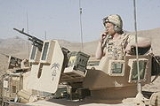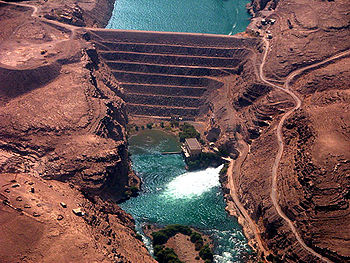
Operation Eagle's Summit
Encyclopedia

International Security Assistance Force
The International Security Assistance Force is a NATO-led security mission in Afghanistan established by the United Nations Security Council on 20 December 2001 by Resolution 1386 as envisaged by the Bonn Agreement...
and Afghan National Army
Afghan National Army
The Afghan National Army is a service branch of the military of Afghanistan, which is currently trained by the coalition forces to ultimately take the role in land-based military operations in Afghanistan. , the Afghan National Army is divided into seven regional Corps. The strength of the Afghan...
troops, with the objective of transporting a 220-tonne turbine to the Kajaki dam in Helmand province
Helmand Province
Helmand is one of the 34 provinces of Afghanistan. It is in the southwest of the country. Its capital is Lashkar Gah. The Helmand River flows through the mainly desert region, providing water for irrigation....
through territory controlled by Taliban insurgents
Taliban insurgency
The Taliban insurgency took root shortly after the group's fall from power following the 2001 war in Afghanistan. The Taliban continue to attack Afghan, U.S., and other ISAF troops and many terrorist incidents attributable to them have been registered. The war has also spread over the southern and...
. Ending in success for the coalition, it involved mostly British
United Kingdom
The United Kingdom of Great Britain and Northern IrelandIn the United Kingdom and Dependencies, other languages have been officially recognised as legitimate autochthonous languages under the European Charter for Regional or Minority Languages...
troops, and was said to have been one of the largest logistical operations carried out by the British Army
British Army
The British Army is the land warfare branch of Her Majesty's Armed Forces in the United Kingdom. It came into being with the unification of the Kingdom of England and Scotland into the Kingdom of Great Britain in 1707. The new British Army incorporated Regiments that had already existed in England...
since World War II. The operation took its name from the eagle pictured on the insignia of the 16th Air Assault Brigade.
Restoring Kajaki dam
USAID began work on the Kajaki hydroelectric dam in 1953, in order to provide electricity and irrigation to the population of Helmand and Kandahar provinces. It was supposed to house three turbines, but only two were ever installed, and after years of civil warCivil war in Afghanistan
The Afghan civil war began when the communist People's Democratic Party of Afghanistan took power in a military coup, known as the Saur Revolution, on 27 April 1978. Most of Afghanistan subsequently experienced uprisings against the unpopular Marxist-Leninist PDPA government. The Soviet Union...
, only one one was still in service by 2001 In 2004, the United States started work on restoring the dam's capacity and bringing its output to 53 megawatts. One turbine was repaired in 2005, but the restoration was hampered by the difficulty of delivering new turbines to Kajaki through Taliban-controlled territory, that required a large-scale military operation.
Alternate route
60 British officers worked for four months in preparing the operation. They planned to avoid taking the most direct route, Highway 611, which crossed several Taliban strongholds, and that was littered with IEDImprovised explosive device
An improvised explosive device , also known as a roadside bomb, is a homemade bomb constructed and deployed in ways other than in conventional military action...
s placed by the insurgents and land mine
Land mine
A land mine is usually a weight-triggered explosive device which is intended to damage a target—either human or inanimate—by means of a blast and/or fragment impact....
s left over from the Soviet presence in Afghanistan
Soviet war in Afghanistan
The Soviet war in Afghanistan was a nine-year conflict involving the Soviet Union, supporting the Marxist-Leninist government of the Democratic Republic of Afghanistan against the Afghan Mujahideen and foreign "Arab–Afghan" volunteers...
. Instead they planned to take the convoy carrying the turbine through the desert, following an itinerary codenamed "route Harriet", that was mapped by the Pathfinder platoon weeks before the operation. The British tried to negotiate safe passage for the convoy, in some cases distributing cash sums to local elders, but these deals didn't work out.
The Chinese
People's Republic of China
China , officially the People's Republic of China , is the most populous country in the world, with over 1.3 billion citizens. Located in East Asia, the country covers approximately 9.6 million square kilometres...
-made turbine was delivered to Kandahar airport on the night of August 27, and was taken through the first part of the journey by Canadian troops, till it reached a meeting point in the desert, where it was taken over by British forces. It was broken down into seven separate loads, each weighing some 30 tonnes, and carried on HET trucks.
The main convoy, composed of 100 vehicles stretching over four kilometres, included 50 Viking APCs
BvS 10
The BvS 10 is an All Terrain Armoured Vehicle produced by BAE Systems Land Systems Hagglunds of Sweden. This vehicle, referred to as the All Terrain Vehicle - ATV or VIKING by the UK forces, was originally developed as a collaboration between industry - Hägglunds Vehicle AB - and the UK Ministry...
, and Jackal and Mastiff
Cougar (vehicle)
The Cougar is an armored fighting vehicle designed to be resistant to anti-vehicle mines and improvised munitions.It is a family of armored vehicles produced by Force Protection Inc, which manufactures ballistic and mine-protected vehicles. The automotives are integrated by Spartan Motors...
vehicles. The whole Combat Logistic Patrol, as the convoys are called in military terminology, was made up of three elements. The Engineer Group (9 Parachute Squadron RE), the Command Group (CO 13 Air Assault Support Regiment RLC) and the Turbine Element (15 Air Assault Close Support Squadron RLC). Amongst the convoy were eight critical vehicles:
- Four Transformers
- Two Stators
- One Upper Bracket Assembly
- 80 Ton Crane
Attack helicopters provided overwatch, while air support
Air Support
Air Support is a 1992 computer game for the Amiga and Atari ST. It is a top-down strategy game, with a first-person mode available for special missions. The game takes place during a retrofuturistic 21st century where all wars are fought in virtual reality. The game was given mostly positive...
came in the shape of US, French and Dutch aircraft. Combat Engineers
Royal Engineers
The Corps of Royal Engineers, usually just called the Royal Engineers , and commonly known as the Sappers, is one of the corps of the British Army....
provided support, by building and shoring up the road the convoy was due to travel on.
Heliborne troops from the Parachute Regiment provided security for the convoy, by leapfrogging along its path.
At the same time, a dummy convoy composed of 30 to 40 Danish
Denmark
Denmark is a Scandinavian country in Northern Europe. The countries of Denmark and Greenland, as well as the Faroe Islands, constitute the Kingdom of Denmark . It is the southernmost of the Nordic countries, southwest of Sweden and south of Norway, and bordered to the south by Germany. Denmark...
vehicles advanced along Highway 611, escorted by the 1st battalion, the Parachute Regiment, in order to deceive the Taliban into ignoring "Harriet".
During the last stretch of the route, the main convoy was obliged to rejoin Highway 611, and travel through 4.5 miles of territory where some 200 insurgents were known to be active. The task of clearing the area was given to a force composed of 388 ANA soldiers and their 42 mentors from a Royal Irish Regiment OMLT
Military transition team
A Military Transition Team, or Transition Team, is a 10-15 soldier team that and trains local forces. The term has been used in the context of the "War on Terror" to design groups training in particular the Iraqi Security Forces, Afghan Army and other Afghan security forces.- Mission :The primary...
. After three days of intensive bombardment from NATO artillery, including MLRS
M270 Multiple Launch Rocket System
The M270 Multiple Launch Rocket System is an armored, self-propelled, multiple rocket launcher; a type of rocket artillery.Since the first M270s were delivered to the U.S. Army in 1983, the MLRS has been adopted by several NATO countries. Some 1,300 M270 systems have been manufactured in the...
rockets, and from coalition aircraft, the road was cleared of insurgents, allowing the convoy to reach its destination on September 3 at 2.30am. It took five days to travel 180 km, during which the convoy had endured very few attacks, and suffered no casualties through Taliban action. During this time British artillery fired 800 105mm shells and 54 rockets. The British claimed to have killed some 200 insurgents, but this claim could not be independently verified.
Casualties
One British soldier was injured in a Road Traffic Accident at Kajaki, and one CanadianCanadian Forces
The Canadian Forces , officially the Canadian Armed Forces , are the unified armed forces of Canada, as constituted by the National Defence Act, which states: "The Canadian Forces are the armed forces of Her Majesty raised by Canada and consist of one Service called the Canadian Armed Forces."...
soldier died and a further seven injured, when their vehicle struck an Improvised Explosive Device
Improvised explosive device
An improvised explosive device , also known as a roadside bomb, is a homemade bomb constructed and deployed in ways other than in conventional military action...
when returning to base.
Outcome
The operation was hailed by NATO as a significant victory, that would contribute to winning the "hearts and minds" of the Afghan people. BrigadierBrigadier
Brigadier is a senior military rank, the meaning of which is somewhat different in different military services. The brigadier rank is generally superior to the rank of colonel, and subordinate to major general....
Carleton-Smith, commander of Task Force Helmand
Task Force Helmand
Task Force Helmand is the name given to a military unit of the International Security Assistance Force in Helmand Province, Afghanistan. Task Force Helmand is currently part of Regional Command Southwest and consists of military forces from countries such as Estonia and the U.K....
, described it as "the end of the beginning" of the fighting in Helmand. However, British engineers estimate that installing the turbines and building a suitable power distribution network will take another two years.

